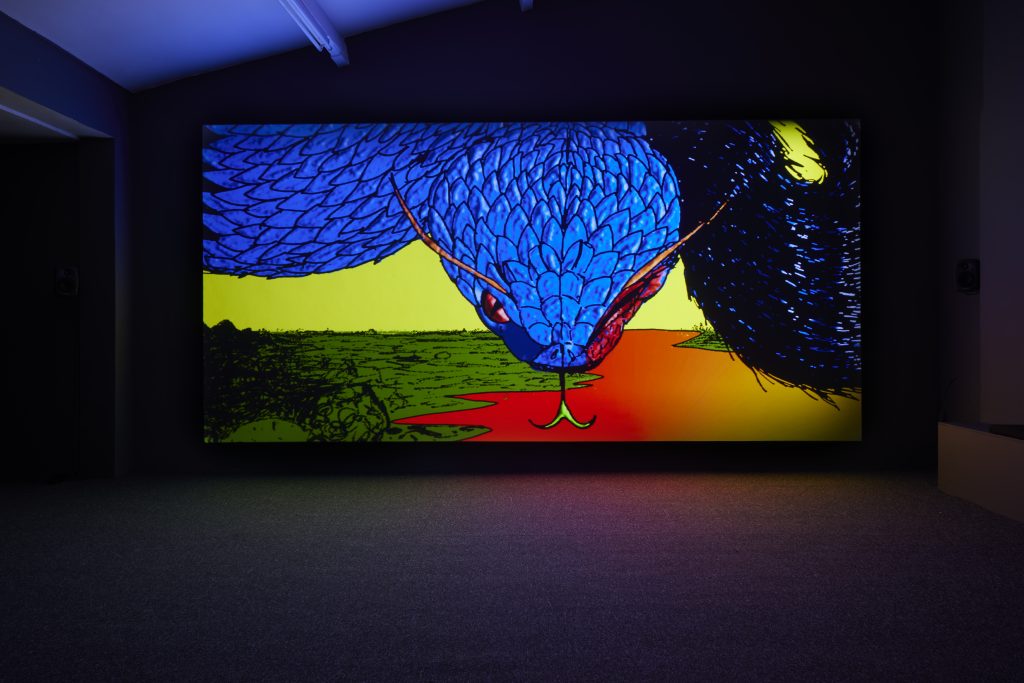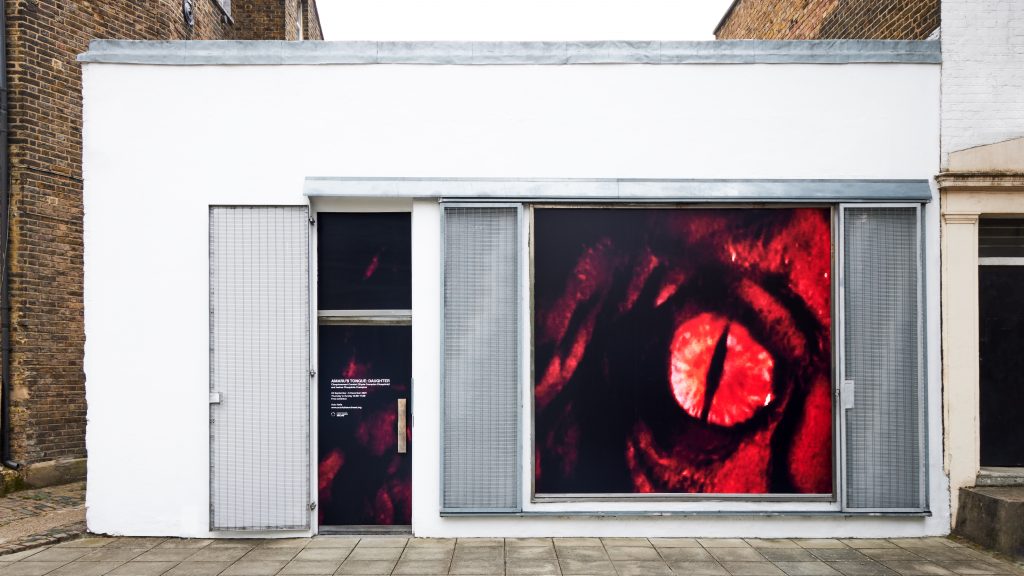A sense of oneness engulfs Amaru’s Tongue: Daughter. Exploring the earth, time and our position as individuals within it, Chuquimamani-Condori (Elysia Crampton Chuquimia) and Joshua Chuquimia Crampton‘s titular solo exhibition at London’s Auto Italia makes one imagine its invigilators sunk into the darkness, illuminated by a single video installation. Its pulsing, bodily soundtrack is heavy with erratic guitar and thrumming bass, looping on repeat. There is an initial sense of disorientation on entering the show—running September 24 to December 5—followed by something more meditative. A feeling of calm rises alongside emotion, where the US-based Aymaran multidisciplinary artists’ subtle and humorous moving-image work examines the notion of death through the context of individual family narratives and societal histories of resistance.

A silicone puppet moulded by the siblings in the likeness of their late grandmother—Flora Tancara Quiñonez Chuquimia—dominates the ‘Amaru’s Tongue: Daughter’ video, which is made up of Super 8mm film, animation and sound bytes. Accompanied by a Chihuahua, the matriarchal mascot moves through a wooded landscape. Strangely lifelike, its synthetic nature is given away by the figure’s moulded features. For the audience watching, the instinct is to try to assign the puppet’s actions with reason. It roots through the undergrowth, holding a sculpture that looks like a bronze cast of two potatoes, seen earlier in archival footage of a family kitchen table that has been collaged into the video. At one point we see casts of faces immersed in the ground. Grandmother Flora speaks to herself and also to her canine companion, through recordings of her own voice. There is a dislocation between the words and the mechanical movements of the mouth, perhaps speaking to the inadequacy of our attempts to conjure a person we have lost.
This surreal quality is reiterated by the set pieces in ‘Amaru’s Tongue: Daughter’: closeups of the Chihuahua’s face, its eyes blazing white like a wolf in a fantasy film; a condor with a spool of wool in its beak, unravelled by Flora’s hands; a hummingbird, animated by the artists. In the tradition of the Aymara—an indigenous nation whose territory overlaps with Bolivia, Chile and Peru—these animals are central figures in the three-year transition to death. In the work, Flora seems to occupy a space between life and death, emphasised by archival footage depicting a ceremony and her funeral; the cultural behaviours we adopt in order to reason with life’s end and the transition to something else. The score that accompanies the film is written and composed by the artists, lending itself to the footage that it’s easy to forget its presence, sounding as natural as breath in the context of the work, but a pacy and unnerving listen when separated.

The latest in in a series of collaborations by Chuquimamani-Condori and Chuquimia Crampton, ‘Amaru’s Tongue: Daughter’ applies to the Aymara idea of ‘qhipnayra’, where the future lies behind us and the past is what’s ahead. Ritual and ceremony is conducted for Flora in the film which, when coupled with these themes, eases the dread of death’s finality. In considering both the non-linearity of time and the idea of our unity with earth, water and fire, it proposes a less finite idea of life, suggesting that our physical existence is only a pinprick of light in a blanket of darkness to which we are both as integral and unnecessary as a grain of sand is to the seabed. Depicting ceremony and the ritualistic aspects of its creation and screening, the film works as both artefact and active agent, positioning the viewer as a privileged onlooker to its remembrance.**
Chuquimamani-Condori (Elysia Crampton Chuquimia) and Joshua Chuquimia Crampton’s Amaru’s Tongue: Daughter is on at London’s Auto Italia, running September 24 to December 5, 2021.













